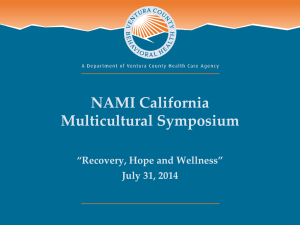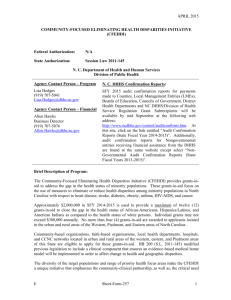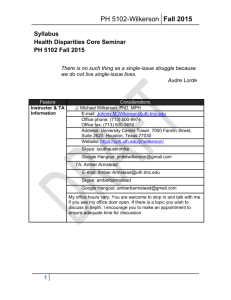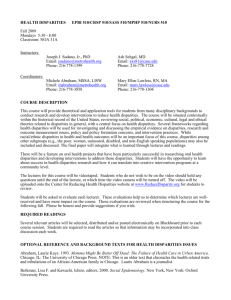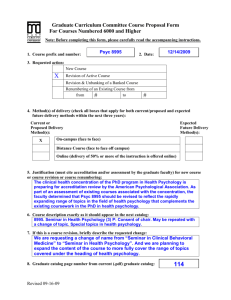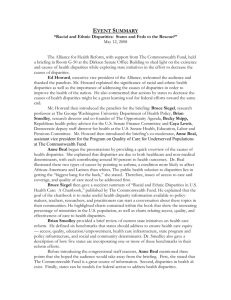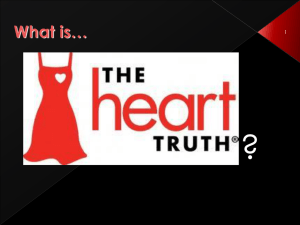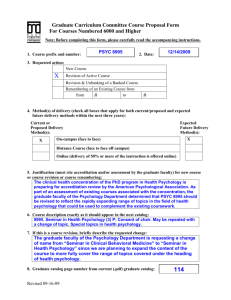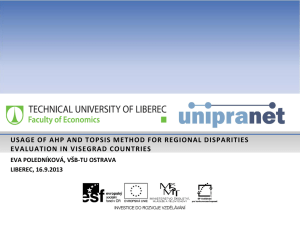Preparing for Strategic Planning PowerPoint
advertisement
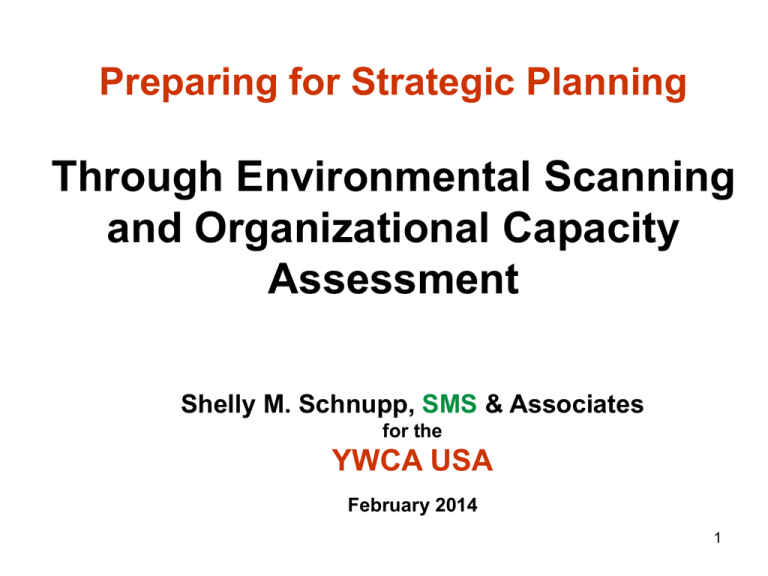
Preparing for Strategic Planning Through Environmental Scanning and Organizational Capacity Assessment Shelly M. Schnupp, SMS & Associates for the YWCA USA February 2014 1 Session Topics I. Introduction/ Context II. Developing Market Awareness through Environmental Scanning III. Defining Competitive Advantage through Organizational Capacity Assessment 2 Strategic Planning …well-formed organizational strategies are the best path for a nonprofit to advance its mission. …most often a consideration of strategy is absent from the strategic planning process. Simply articulated, it (strategy) is an organized pattern of behavior toward an end. David LaPiana, 2008 3 Developing effective strategy requires: Understanding our market Knowing our competitive advantage Awareness of Internal and external challenges Identify crises and opportunities 4 Developing Market Awareness through Environmental Scanning 5 Strategy development requires: Market Awareness Clarify our market—stable, shrinking, growing? Changing? Other players—how do we stack up? What forces might shape our future? • Current and Potential Customers Analysis • Trend Analysis • Competitor Analysis 6 Customer Analysis: Data Sources Relevant Population Statistics Incident statistics (education, crime, teen pregnancy, health, etc.) Disparity Data. Results of studies Service and outcomes data Surveys and Focus Groups 7 Find and Review Existing Data A large volume of community-related data is routinely collected by various government agencies and community groups. Analyzing this data can be useful in identifying community problems and needs. Existing statistical data can be used to obtain insights about the well-being of people. 8 Challenges facing our Market: Disparities Racial Justice Women of color are 1.5 x more likely to live in poverty than white women. The median earnings for women of color is 28% less than for white women. Incidence of homeless women increased 10% from previous decade; greatest increases among women of color. Women’s Economic Empowerment Single-mother families have the highest poverty rates of any household type—1 of every 2 families. Women earn 77 cents for every dollar earned by men. 9 Disparities: The condition or fact of being unequal. Health disparities are differences in the incidence, prevalence, mortality, burden of diseases and other adverse health conditions or outcomes. 10 Disparities – Elected Office In 2009, women held 90 or 16.8% of the 535 seats in the 111th U.S. Congress. In 2009, 1,791 or 24.3% of the 7,382 state legislators in the U.S. were women. 72 women held 22.9% of statewide elected executive office positions (governor, lt. governor, attorney general, etc.) What is the situation in your state or community? 11 Disparities -- Education Nearly two-thirds of low income working mothers (62 percent) have only a high school education or less, compared with less than one-third of higher income working mothers (32 percent). More than two-thirds of higher-income working mothers (68 percent) have some college education or more, whereas only 38 percent of low-income working mothers do. African American women are less likely than white women to hold bachelor’s degrees or higher, with only 16.7% of African American women holding bachelor’s degrees in 2004, compared with 24.6% of white women. Having at least some college education improves wages by 25 percent or more. Disparities – Criminal Justice Blacks were almost three times more likely than Hispanics and five times more likely than whites to be in jail. Overall, data from the Bureau of Justice document that one in six black men had been incarcerated as of 2001. In 2005, Hispanics comprised 20% of the state and federal prison population, a rise of 43% since 1990. Trends Data is even Better….. Look for Explanations of Disparities Look for Explanations of Disparities Competitor Analysis Strongest direct and suitable competitors: for customers, publicity, human resources, funding Strengths as well as weaknesses What do you admire about each competitor? David LaPiana, 2009 17 Sources of Market Data Local newspaper, journals Local and National Foundations, United Way Research Institutes, Advocacy Groups University studies Local government Workforce development initiatives Health Department School District Police Department Housing Authority Surveys, Focus Groups 18 What Data do we Need? Which issues, situations, disparities are of particular interest? Why? What clues does our mission and vision offer? Which individuals are most affected? Why? What do we already know or believe to be true? What evidence supports our beliefs? What don’t we know? What questions do we need to have answered? What outside resources can we tap for information? 19 Start with What you Know What have we learned from our own experience? What have staff learned? Have we collected data for our strategic plan? What other studies have been done in our community or nationally? Can we rely on this information to give insight and answers? Decide what you still need to know. Caution—studies may be outdated and conventional wisdom can be wrong. 20 Determine what Methods to use to Collect Additional Information Consider : Time available Available resources The scope of the information needed Consider Combined Methods Surveys and focus groups Disparities data and key informant interviews Social indicators data and community forums 21 Using Environmental Scan Results to inform strategy Look beyond symptoms Review trends data whenever possible Look for patterns and general impressions • What is the status of our mission-focused market? • Are problems increasing? Decreasing? Changing? • Who are our competitors? 22 Specific Sources of Mission-Related Existing Data U.S. Census Bureau State and County Quick Facts—State, City, County Population, Race, Household, Housing Business http://www.census.gov/ Studies by topic area: Urban Institute: www.urban.org/ See Low-Income Working Families Project (LIWF Fact Sheet and more) See Browse by Topic: Race, Ethnicity, Gender 23 Sources of Information about YWCA Mission-Related Problems, Disparities Diversity Inc. www.diversityinc.com/ sometimes offers free online 1 year subscriptions See Diversity Facts: http://www.diversityinc.com/department/168/Diversity-Facts/ See Demographic Facts: http://www.diversityinc.com/department/174/Demographic-Facts/ AAUW www.aauw.org/ advances equity for women and girls through advocacy, education, philanthropy and research. See Public Perceptions of the Pay Gap www.aauw.org/research/upload/perceptionsPayGap.pdf 24 More Disparities Data Sources Institute for Women’s Policy Research www.iwpr.org Status of Women in the States See Best and Worst State Economies for Women http://www.iwpr.org/pdf/R334_BWStateEconomies2006.pdf Center for American Women and Politics, Rutgers, the State University of New Jersey www.cawp.rutgers.edu/ See Fast Facts Elections 2010 http://www.cawp.rutgers.edu/fast_facts/elections/candidates 25 _2010.php More Disparities Data Sources Applied Research Center – www.arc.org. a racial justice think tank and home for media and activism. “ARC is built on rigorous research and creative use of new technology. Our goal is to popularize the need for racial justice and prepare people to fight for it.” Office of Minority Health, U.S. Dept. of HHS http://minorityhealth.hhs.gov good source of race-based health disparities. 26 More Disparities Data Sources Haywood Burns Institute for Juvenile Justice Fairness and Equity http://www.burnsinstitute.org/state_map.php Health--Families USA is a national nonprofit, nonpartisan organization dedicated to the achievement of high-quality, affordable health care for all Americans. Henry J. Kaiser Family Foundation www.kff.org Understanding Competitive Advantage through Capacity Assessment 28 Developing strategy requires: Understanding our Competitive Advantage What value do beneficiaries believe we add as compared to others? How strong is our ability to make a difference? How strong is our execution? Customer Feedback Performance Measurement Capacity Assessment 29 Why Capacity Assessment? Identify areas of capacity that are strongest and those that need improvement Measure changes in an organization's capacity over time To draw out different views within an organization; develop a common understanding among leaders regarding what needs to be done Ensure a strong foundation from which to undertake a major change effort Determine how your association compares others (competitive advantage) and to established standards 30 Capacity Assessment & Benchmarking Tool 9 Capacity Element Areas Four levels of capacity Self-scoring Snapshot of your YWCA association’s capacity Defines effectiveness Helps define competitive advantages…and disadvantages 31 Capacity Elements Mission, Vision & Strategy Executive Staff Leadership Management & Development of HR Service Delivery & Impact Board Governance Financial & Legal Management Resource & Revenue Development Strategic Relationships Operations and Infrastructure 32 4 Levels of Capacity LEVEL FOUR: High level of LEVEL THREE: capacity in place Moderate level of LEVEL TWO: capacity in place Basic level of capacity in LEVEL ONE: place Clear need for increased capacity Rating our Capacity Use a team approach: staff and board Focus on descriptions for each category Proceed through each section; reach consensus on levels we meet Add comments for each Element area Note: capacity levels are driven by many factors There are no “right” answers 34 Good Assessment Practices Approach assessment as a learning opportunity Encourage atmosphere of honesty: “if we’re not completely at level 3 we rate our selves at level 2 Keep notes about issues that surface Take the time needed 35 Using CB Assessment Results to inform strategy Find the capacity assessment categories with the lowest scores Give special attention to assessment categories listed in first element: “Mission, Vision & Strategy” Avoid focusing on symptoms of deeper issues and “pet priorities” Look for patterns and general impressions Internal Strengths? Weaknesses? Areas of competitive advantage? 36 Trying to improve the community without first understanding it is like trying to sell pocket protectors to ballet dancers! 37 Resources Planning and Conducting Needs Assessments: A Practical Guide. Wikin, B.R., Altschuld, J.W.,1995. Capacity Assessment Tool, developed for YWCA associations by Frank Martinelli and Shelly Schnupp, 2011. The Nonprofit Strategy Revolution. David La Piana, 2008. 38 For more information… Shelly Schnupp SMS and Associates shellyschnupp@aol.com 414-412-0408 39
